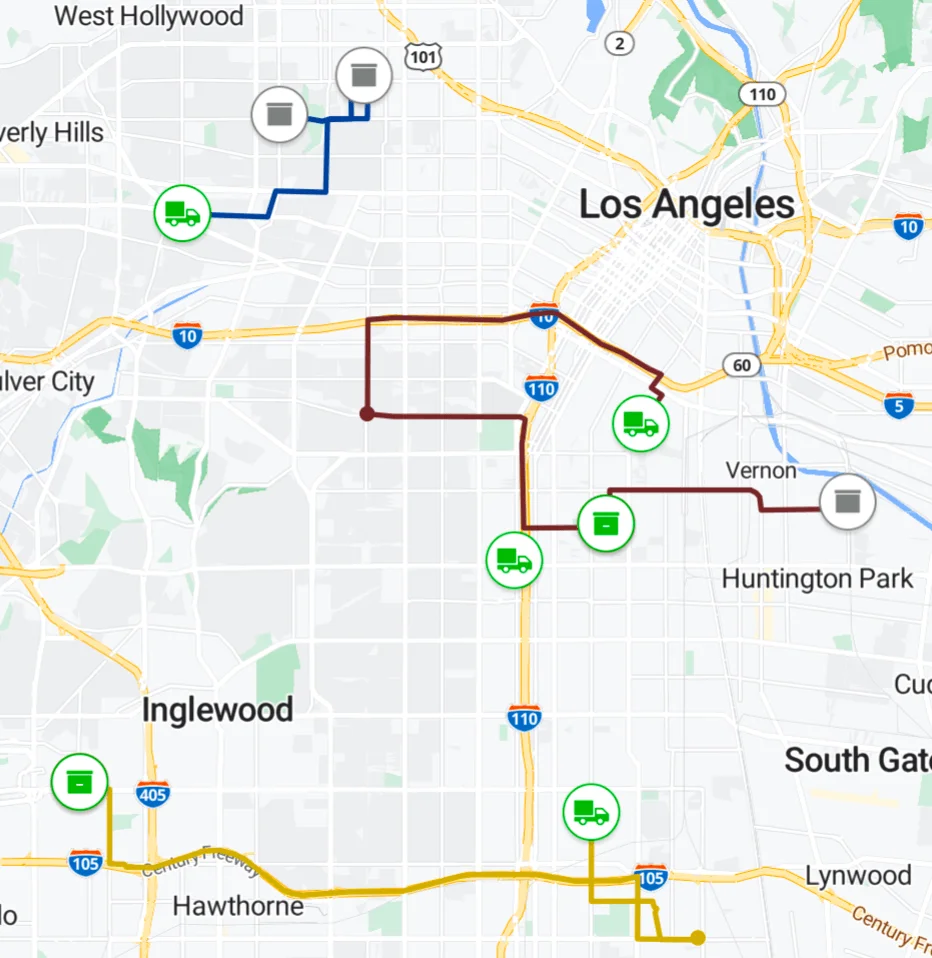
Table of Contents
Table of Contents
When managing a fleet or operating vehicles, understanding the various costs associated with vehicle usage is critical. Vehicle costs go beyond the purchase price, encompassing ongoing expenses such as fuel, maintenance, insurance, and depreciation. By mastering these different cost categories, you can better control your budget, optimize vehicle usage, and make informed decisions about fleet management. This guide breaks down the key types of vehicle costs to help you gain a comprehensive view of what impacts your bottom line.
Use Cases That Benefit from the Flexibility of Setting Different Types of Vehicle Costs
Optimizing routes based on fixed cost, cost per order, cost per unit distance, and cost per unit time is essential for improving efficiency and profitability across various industries. Here are key use cases where this flexibility delivers significant benefits:
1. Last-Mile Delivery for E-Commerce
Context: E-commerce companies must deliver parcels to multiple customers within tight deadlines, with high expectations for fast and cost-effective shipping.
Benefits:
Fixed cost: Helps determine how many delivery vehicles to deploy daily to minimize operational costs.
Cost per order: Ensures each vehicle carries the maximum number of orders to reduce delivery costs.
Cost per unit distance: Optimizes routes to minimize fuel consumption and create efficient delivery zones.
Cost per unit time: Reduces labor costs by optimizing driver hours, ensuring timely deliveries.
2. Food and Grocery Delivery Services
Context: Companies like Instacart and UberEats must deliver perishable goods quickly, adhering to customer time windows.
Benefits
Fixed cost: Determines how many vehicles should operate based on demand.
Cost per order: Batching multiple deliveries on a single trip lowers costs.
Cost per unit distance: Reduces travel distance to save fuel and vehicle wear in urban settings.
Cost per unit time: Minimizes delivery delays by avoiding traffic, ensuring timely service.
3. Parcel and Freight Transportation
Context: Logistics companies like UPS and FedEx transport large volumes of goods over long distances, often across borders.
Benefits:
Fixed cost: Balances fleet deployment to match shipment volume.
Cost per unit distance: Optimizes travel routes to minimize fuel and transport costs.
Cost per unit time: Critical for express deliveries, reducing penalties for delays.
4. Waste Collection and Recycling Services
Context: Municipal and private companies collect waste and recyclables while adhering to strict schedules.
Benefits:
Fixed cost Balances the number of collection trucks based on operational efficiency.
Cost per order: Groups collection points to reduce the number of stops per vehicle.
Cost per unit distance: Minimizes travel distance to reduce fuel consumption.
Cost per unit time: Reduces delays in urban traffic, improving overall collection efficiency.
5. Field Service and Maintenance Operations
Context:: Utility and maintenance companies need to dispatch technicians to various locations for repairs and support.
Benefits:
Fixed cost:Optimizes technician or vehicle deployment based on service demand.
Cost per order: Helps technicians handle multiple service calls in one trip, increasing productivity.
Cost per unit distance: Reduces travel time between service locations to save on fuel.
Cost per unit time: Minimizes downtime between appointments, optimizing technician schedules.
6. Pharmaceutical and Medical Supply Delivery
Context: Delivering medical supplies like vaccines and drugs requires strict scheduling and temperature-controlled transport.
Benefits:
Fixed cost: Optimizes the number of vehicles, particularly temperature-controlled ones.
Cost per order: Reduces trip frequency by batching medical supply deliveries.
Cost per unit distance: Ensures faster, fuel-efficient delivery of time-sensitive medical supplies.
Cost per unit time: Reduces delays for critical deliveries, such as organs for transplant.
7. Ride-Sharing and Taxi Services
Context: Ride-hailing companies like Uber and Lyft must pick up and drop off passengers efficiently, maximizing driver utilization.
Benefits:
Fixed cost: Helps decide the number of drivers to deploy based on demand forecasts.
Cost per order: Reduces unassigned vehicles, maximizing the number of ride requests fulfilled.
Cost per unit distance: Minimizes “dead miles” to reduce fuel and maintenance costs.
Cost per unit time: Reduces time spent on trips, optimizing driver earnings and company costs.
These use cases highlight the need for flexible vehicle cost configurations in route optimization, leading to more efficient operations, better decision-making, and improved profitability.
What is the Feature of Vehicle Costs?

The vehicle cost feature allows users to define multiple types of costs for each vehicle, which directly influence the type of solution generated by the optimizer. By incorporating these costs, the optimizer can adjust task assignments and sequences based on the defined cost structure, ultimately impacting the overall efficiency and cost-effectiveness of fleet operations.
Types of Costs
NextBillion.ai offers four primary types of costs that can be configured for each vehicle:
- Fixed Costs: A constant cost incurred regardless of usage.
- Per-Order Costs: Costs added for every order assigned to the vehicle.
- Per Kilometer (per_km) Costs: Costs calculated based on the distance traveled.
- Per Hour (per_hour) Costs: Costs based on the time the vehicle is in use.
Cost Configuration
For each vehicle, you can configure the following costs:
- Fixed
- Per Order
- Either “Per Kilometer” or “Per Hour” (but not both simultaneously)
This flexible cost configuration allows users to reflect real-world operational constraints in their optimization model.
Impact on Task Sequence and Route Optimization
Once the costs are defined for all vehicles, the optimizer uses this information to determine the most efficient task sequence and routes. The goal is to minimize the total cost while completing the maximum number of tasks. The combination of cost types allows the optimizer to adapt to various operational scenarios, providing the most cost-effective solution.
This feature is critical for integrating real-world costs into the optimization problem, giving the optimizer the necessary input to generate solutions that reflect actual operational priorities.
What is the Need for Vehicle Costs?
Configuring various vehicle costs in route optimization is crucial for achieving precise, realistic, and cost-effective solutions. By incorporating different cost types, route optimization algorithms can account for real-world constraints and influence key aspects of decision-making.
Balanced Cost Minimization
By considering all cost types, the optimization algorithm can balance costs to identify the most cost-effective routes. For instance, a longer route with more orders may still be more profitable even if distance costs increase, as the fixed and per-order costs are distributed more efficiently.
Vehicle and Fleet Utilization
These costs help optimize fleet usage by ensuring that only the required number of vehicles are deployed. This minimizes unnecessary fixed, hourly, or distance-related costs, enhancing the overall cost-efficiency of fleet management.
Scalability
Variable costs per order, time, and distance allow the algorithm to scale solutions across diverse operational scenarios, such as:
- Urban vs. rural deliveries
- High-priority vs. low-priority customers
- Peak vs. off-peak demand times
This flexibility ensures that the algorithm can adapt to varying conditions and business needs.
Benefits of Fixed Costs
Vehicle Selection: Fixed costs help prioritize more cost-efficient vehicles, especially for short routes or low-demand scenarios where distance or time costs don’t outweigh fixed expenses.
Route Consolidation: Encourages combining deliveries when fewer vehicles can achieve the same objectives at a lower overall cost, reducing unnecessary vehicle deployment.
Benefits of Cost Per Order
Order Batching: Minimizes cost per order by encouraging the grouping of multiple deliveries into a single trip.
Efficient Customer Assignments: Helps in determining which orders should be grouped and assigned to specific vehicles, reducing the total number of orders served by each vehicle and optimizing delivery routes.
Benefits of Per Kilometer (per_km) Costs
Route Length Minimization: Encourages the algorithm to select the shortest or most efficient routes, lowering fuel consumption and other distance-based expenses.
Geographic Clustering: Groups nearby customers on the same route to minimize the distance between stops, leading to more efficient routes.
Benefits of Per Hour (per_hour) Costs
Time-Sensitive Routing: Optimizes the total time spent on routes, helping meet time windows and improving service speed by minimizing route duration.
Configuring multiple vehicle cost types ensures that route optimization reflects real-world operational constraints. This leads to more informed decision-making, better fleet utilization, and more efficient, cost-effective routing strategies.
In conclusion, NextBillion.ai‘s Route Optimization API provides a robust solution for mastering vehicle usage costs. With support for both fixed and per_hour cost attributes, it allows businesses to optimize routes based on the actual operational expenses. Fixed costs cover expenses like driver fees and taxes, while per_hour costs account for the hourly operation of vehicles. This dynamic cost integration ensures that route planning not only meets time and location constraints but also minimizes overall expenses. By leveraging these vehicle cost parameters, businesses can enhance efficiency and reduce costs, all while maintaining optimal route performance.
About Author
Rishabh Singh
Rishabh Singh is a Freelance Technical Writer at NextBillion.ai. He specializes in Programming, Data analytics and technical consulting, turning complex tech into clear and engaging content.
Ready to get started?
Related Posts


Skill-Based Routing in Route Planning and Dispatch













